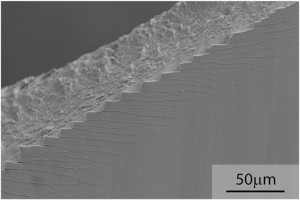
In palladium-based bulk metallic glass, the extensive formation and proliferation of shear bands along fan-shaped slip lines results in significant crack-tip blunting
From the production of tougher, more durable smart phones and other electronic devices, to a wider variety of longer lasting biomedical implants, bulk metallic glasses are poised to be mainstay materials for the 21st Century.
Featuring a non-crystalline amorphous structure, bulk metallic glasses can be as strong or even stronger than steel, as malleable as plastics, conduct electricity and resist corrosion. These materials would seem to have it all save for one problem: they are often brittle, with a poor and uneven resistance to fatigue that makes their reliability questionable.
The creation of multicomponent bulk-metallic glass composites is addressing this issue but the problem remains for monolithic metallic glasses, which are major components of bulk metallic composites.
A new study by a collaboration of Berkeley Lab and Caltech researchers may point the way to improving the fatigue resistance of monolithic bulk glasses. The collaboration found that a bulk metallic glass based on palladium displayed a fatigue strength as good as the best composite bulk metallic glasses and comparable to regular polycrystalline structural alloys, such as steel, aluminum and titanium. This study was led by Robert Ritchie, a materials scientist with Berkeley Lab’s Materials Sciences Division and Caltech’s William Johnson, one of the pioneers in the field of bulk metallic glass fabrication.

SEM micrograph image of a bulk metallic glass under load shows a “staircase-like” crack path whose serrations resemble interlocking gear teeth that act to limit the opening and closing of cracks.
“We found that the unexpectedly high fatigue resistance in monolithic palladium-based bulk metallic glass arises from extensive shear-band plasticity that results in a periodic staircase-like crack profile,” Ritchie says. “The ease with which shear bands form in this palladium-based glass generates highly serrated cracks that resemble interlocking gear teeth and provide crack-tip blunting and shielding to limit the opening and closing of cracks. The effect is somewhat like trying to speak with a doughnut in your mouth.”
Palladium is a metal with a high “bulk-to-shear” stiffness ratio that counteracts the intrinsic brittleness of glassy materials because the energy needed to form shear bands is significantly lower than the energy required to turn these shear bands into cracks.
“The effect of multiple shear-banding is multifold,” Ritchie says. “The formation of shear bands leads to extensive crack-tip blunting, which leads to intrinsic toughening, whereas the resulting crack deflections and closures lead to crack-tip shielding, which leads to extrinsic toughening. These mechanisms, together with the high fatigue threshold, provide the major contributions to the excellent fatigue endurance strength shown by the monolithic palladium-based bulk metallic glass.”
The results of this study have been published in the Proceedings of the National Academy of Sciences. It is titled “Enhanced fatigue endurance of metallic glasses through a staircase-like fracture mechanism.” Ritchie and Johnson are the corresponding authors. Other co-authors are Bernd Gludovatz, Marios Demetriou, Michael Floyd and Anton Hohenwarter.

No comments:
Post a Comment